Plymouth Voyager
| Plymouth Voyager/Grand Voyager | |
|---|---|
|
| |
| Overview | |
| Manufacturer |
Chrysler Corporation (1974-1998) DaimlerChrysler (1998-2000) |
| Also called | Chrysler Voyager/Grand Voyager (Mexico; USA for 2000 only) |
| Production | 1974–2000 |
| Body and chassis | |
| Class |
Minivan (1984–2000) Full-size van (1974–1983) |
| Chronology | |
| Successor | Chrysler/Lancia Voyager (USA, 2001–2003, Mexico SWB until 2007) |
Plymouth Voyager is a nameplate for a range of vans that were marketed by the Plymouth division of Chrysler. From 1974 to 1983, the Plymouth Voyager was sold as the Plymouth counterpart of the Dodge Sportsman full-size van. For the 1984 model year, the nameplate was moved to Chrysler minivan product line. Marketed as the Plymouth counterpart of the Dodge Caravan from 1984 to 2000, the Plymouth Voyager minivan was sold across three generations.
Chrysler phased out the Plymouth division after the 2000 model year, with the Voyager added to the Chrysler model line (as a base-trim version of the Chrysler Town & Country). While the Chrysler Voyager had been the nameplate used for export-market minivans since 1988 (and remained so through 2016), the rebadging of the Plymouth Voyager as a Chrysler ended after the 2003 model year.
When including the Plymouth Voyager and Dodge Caravan with their rebadged Chrysler, Lancia, and Volkswagen variants, the Chrysler minivans collectively rank as the 13th best-selling automotive model line worldwide.[1]
Full-size van (AB; 1974-1983)
| Full-size Voyager | |
|---|---|
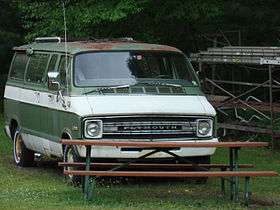 | |
| Overview | |
| Also called |
Dodge Sportsman Dodge Ram Wagon |
| Production | 1974–1983 |
| Body and chassis | |
| Body style |
4-door van 6-door van |
| Layout | FR layout |
| Platform | Chrysler AB platform |
| Powertrain | |
| Engine |
318 cu in (5.2 L) LA V8 360 cu in (5.9 L) LA V8 |
| Transmission | 3-speed TorqueFlite automatic |
From 1974 to 1983, the Plymouth Voyager was the Plymouth counterpart of the Dodge Sportsman (the Dodge Ram Wagon after 1980). The first truck marketed by Plymouth since 1942, the Voyager was introduced alongside the 1975 Plymouth Trail Duster (a counterpart of the Dodge Ramcharger). As with the Sportsman, the Voyager was produced with 12-15 passenger seating.[2][3]
Similar to Canadian Fargo vans, Plymouth badged the Voyager with "Plymouth" lettering centered in the grille instead of Dodge lettering on the hood. In 1978, the lettering was moved to the hood. Initially located on the driver side, the Plymouth lettering was centered for 1979, as the grille was enlarged and restyled. For 1979 and 1980, the Plymouth Voyager and Dodge Royal Sportsman were largely indistinguishable; latter examples of the Voyager are distinguished by the lack of large "RAM" badging on the door.
In contrast to its Dodge counterpart, the Plymouth Voyager was equipped with a V8 engine as standard equipment. However, the Voyager was only offered with the 318 and 360 V8s (the 400 and 440 V8 engines were available in Dodge vans prior to 1979).
Background
Lee Iacocca and Hal Sperlich had conceived their idea for a modern minivan during their earlier tenure at Ford Motor Company. Henry Ford II had rejected Iaccoca's and Sperlich's idea (and a prototype) of a minivan in 1974, then rumored to carry the name "Maxivan". Iaccoca followed Sperlich to Chrysler Corporation, and together they created the T115 minivan — a prototype that was to become the Caravan and Voyager, known colloquially as the "Magic-wagons" (a term used in advertising).
The Chrysler minivans launched a few months ahead of the Renault Espace (the first MPV/minivan in Europe, initially presented to executives as a Talbot (which was made up of Chrysler Europe's disposed assets) in 1979,[4] but not launched until 1984), making them the first of their kind — effectively creating the modern minivan segment in the US.
First generation (S; 1984–1990)
| First generation (S) | |
|---|---|
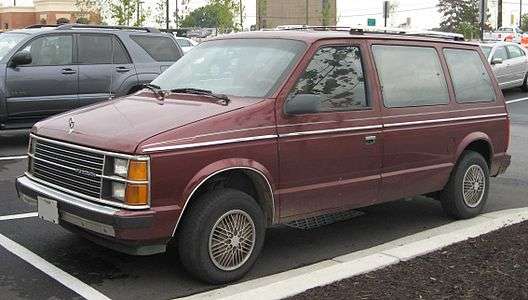 | |
| Overview | |
| Production | 1984–1990 |
| Assembly | Windsor Assembly, Windsor, Ontario, Canada |
| Body and chassis | |
| Body style | 3-door minivan |
| Layout | Transverse front-engine, front-wheel drive |
| Platform | Chrysler S platform |
| Related |
Dodge Caravan Chrysler Town & Country Chrysler Voyager |
| Powertrain | |
| Engine |
2.2 L K I4 2.5 L K I4 2.5 L Turbo I4 2.6 L Mitsubishi G54B I4 3.0 L Mitsubishi 6G72 V6 3.3 L EGA V6 |
| Transmission |
4-speed A460 manual 5-speed manual 3-speed A413 automatic 3-speed A470 automatic 3-speed A670 automatic 4-speed A604 automatic |
| Dimensions | |
| Wheelbase |
Grand: 119.1 in (3,025 mm) SWB: 112 in (2,845 mm) |
| Length |
Grand: 190.5 in (4,839 mm) SWB: 175.9 in (4,468 mm) SWB LE: 177.3 in (4,503 mm) 1989-1990 Grand LE: 191.9 in (4,874 mm) |
| Width |
1984-88: 72.2 in (1,834 mm) 1989-1990: 72 in (1,829 mm) |
| Height |
1984-88 SWB: 64.4 in (1,636 mm) 1984-88 Grand: 64.7 in (1,643 mm) 1989-1990: 64.8 in (1,646 mm) |

In 1984, Chrysler marketed the rebadged Plymouth variant of its new minivan as the Voyager, using the Chrysler's S platform, derived from the K-platform (Plymouth Reliant and Dodge Aries). The Voyager shared components with the K-cars including portions of the interior, e.g., the Reliant's instrument cluster and dashboard controls, along with the K-platform front-wheel drive layout and low floor, giving the Voyager a car-like ease of entry. The Voyager was on Car and Driver magazine's Ten Best list for 1985.[5]
For 1987, the Voyager received minor cosmetic updates as well as the May 1987 introduction of the Grand Voyager, which was built on a longer wheelbase adding more cargo room. It was available only with SE or LE trim.
First-generation Voyager minivans were offered in three trim levels: an unnamed base model, mid-grade SE, and high-end LE, the latter bearing simulated woodgrain paneling. A sportier LX model was added in 1989, sharing much of its components with the Caravan ES.
Safety features included 3-point seat belts for the front two passengers and lap belts for rear passengers. Standard on all Voyagers were legally mandated side-impact reinforcements for all seating front and rear outboard positions. Safety features such as airbags or ABS were not available.[6]
Original commercials for the 1984 Voyager featured magician Doug Henning[7] as a spokesperson to promote the Voyager "Magic Wagon's" versatility, cargo space, low step-in height, passenger volume, and maneuverability. Later commercials in 1989 featured rock singer Tina Turner.[8] Canadian commercials in 1990 featured pop singer Celine Dion.[9]
Seating
1984-1986 Voyagers could be equipped for five, six, seven passengers, with an eight-passenger variant available only in 1985.[10] Five-passenger seating, standard on all trim levels, consisted of two front bucket seats and an intermediate three-passenger bench seat. In 1985, on base and SE models, the front buckets could be replaced by a 40/60 split three-passenger bench seat, bringing the total number of occupants to six. Seven-passenger seating was an option on SEs and LEs, with dual front buckets, an intermediate two-passenger bench, and a rear three-passenger bench. Eight-passenger seating was available on SE models only, with both the additional middle two-passenger bench and three-passenger front bench. Depending on configuration, the base model could seat up to six, the SE could seat up to eight, and the LE could seat up to seven.
The two bench seats in the rear were independently removable, and the large three-seat bench could also be installed in the 2nd row location via a second set of attachment points on the van's floor, ordinarily hidden with snap-in plastic covers. This configuration allowed for conventional five-passenger seating with a sizable cargo area in the rear. The latching mechanisms for the benches were very intuitive and easy to operate.
On base models, the front buckets were low-back items, upholstered with plain cloth or vinyl. On SEs, the buyer could choose between low-back buckets with deluxe cloth or high-back buckets in upgraded vinyl. LEs came standard with high-back front buckets, upholstered in either luxury cloth or luxury vinyl.
In 1985 and 1986, there was also a five-passenger version with a back seat that could be folded flat with the pull of a handle into a bed that filled the rear compartment from the back of the front seats to the rear. This option was known as the Magic Camper. The Magic Camper back seat had an extra rear-facing cushion that formed the back-most section of the bed when folded flat and the seat, though very heavy, was removable. The Magic Camper option included a tent that attached magnetically to the side of the vehicle allowing access in and out of the sliding side door.
For 1987 the six- and eight-passenger options were withdrawn, leaving seating for five standard and for seven optional on the base and SE, and seating for seven with high-back front buckets standard on the LE, Grand SE, and Grand LE. Deluxe cloth upholstery was now standard on base and all SE models, with the luxury vinyl optional on SEs. On LEs, luxury cloth came standard and for the first time, leather seats were available on the LE models.
Engines
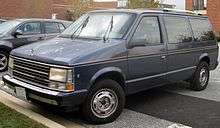
For the first 3 years of production, two inline-4 engines with 2 barrel carburetors were offered. The base 2.2L was borrowed from the Chrysler K-cars, and produced 96 hp (72 kW) horsepower. The higher performance fuel injected version of the 2.2L engine later offered in the Chrysler K-cars was only offered in the Voyager for the 1987 model year, and would remain the base powerplant until mid-1987. Alongside the 2.2L, an optional Mitsubishi 2.6L engine was available producing 104 hp (78 kW) horsepower.
At launch, the Voyager's low horsepower to weight ratio had not been much of a concern. Its main competitors were the Toyota Van and the Volkswagen Vanagon, both of which offered similar performance. In mid-1987, the base 2.2L I4 was replaced with a fuel-injected 2.5L I4, which produced 100 hp (75 kW), while the Mitsubishi G54B I4 was replaced with the new fuel-injected 3.0L Mitsubishi V-6 producing 136 hp (101 kW) in March of that year.
A turbocharged version of the base 2.5L producing 150 hp (112 kW) was available in 1989 and 1990. Also in 1989, revisions to the Mitsubishi V-6 upped its output to 142 hp (106 kW). In 1990, a new 150 hp (110 kW) 3.3L V-6 was added to the option list. Sales of the 2.5 turbo dwindled as a result, and it was dropped at the end of the year.
- 1984–1987 2.2 L K I4, 96 hp (72 kW), 119 lb⋅ft (161 N⋅m)
- 1984–1987 2.6 L Mitsubishi G54B I4, 104 hp (78 kW), 142 lb⋅ft (193 N⋅m)
- 1987½–1990 2.5 L K I4, 100 hp (75 kW), 135 lb⋅ft (183 N⋅m)
- 1987½–1988 3.0 L Mitsubishi 6G72 V6, 136 hp (101 kW), 168 lb⋅ft (228 N⋅m)
- 1989–1990 2.5 L Turbo I4, 150 hp (110 kW), 180 lb⋅ft (240 N⋅m)
- 1989-1990 3.0 L Mitsubishi 6G72 V6, 142 hp (106 kW), 173 lb⋅ft (235 N⋅m)
- 1990 3.3 L EGA V6, 150 hp (110 kW), 180 lb⋅ft (240 N⋅m)
Transmissions
Both a three-speed TorqueFlite automatic transmission and a five-speed manual were available with all inline-4 engines, including the turbocharged 2.5 L (this was a rare combination). V-6 engines were only offered with the venerable fully hydraulically operated TorqueFlite, until the computer controlled Ultradrive 4-speed automatic became available in 1989. The Ultradrive offered much better fuel economy and responsiveness, particularly when paired with the inline-4 engine.
Second generation (AS; 1991–1995)
| Second generation (AS) | |
|---|---|
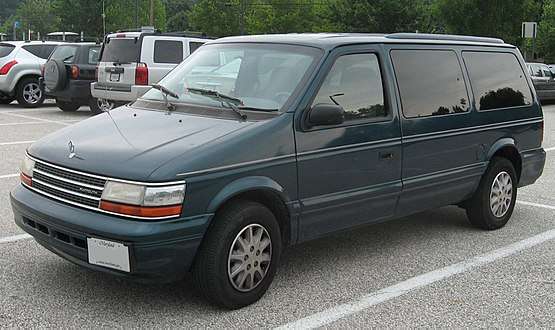 | |
| Overview | |
| Also called | Chrysler Voyager (Mexico) |
| Production | August 14, 1990–August 1995 |
| Assembly |
St. Louis, Missouri, United States Windsor, Ontario, Canada |
| Body and chassis | |
| Body style | 3-door minivan |
| Layout | Transverse front-engine, front-wheel drive / all-wheel drive |
| Platform | Chrysler AS platform |
| Related |
Chrysler Town & Country Dodge Caravan |
| Powertrain | |
| Engine |
2.5 L K I4 3.0 L Mitsubishi 6G72 V6 3.3 L EGA V6 3.8 L EGH V6 |
| Transmission |
5-speed manual 3-speed TorqueFlite automatic 4-speed Ultradrive automatic |
| Dimensions | |
| Wheelbase |
SWB: 112.3 in (2,852 mm) Grand: 119.3 in (3,030 mm) |
| Length |
SWB: 178.1 in (4,524 mm) Grand: 192.8 in (4,897 mm) |
| Width | 72 in (1,829 mm) |
| Height |
SWB: 64.2 in (1,631 mm) Grand: 64.8 in (1,646 mm) 1991-93 AWD: 65.9 in (1,674 mm) 1994-95 AWD: 65.8 in (1,671 mm) 1994-95 LE SWB: 64.3 in (1,633 mm) |
| Curb weight |
3,305 lb (1,499 kg) 3,531 lb (1,602 kg) (Grand Voyager) |
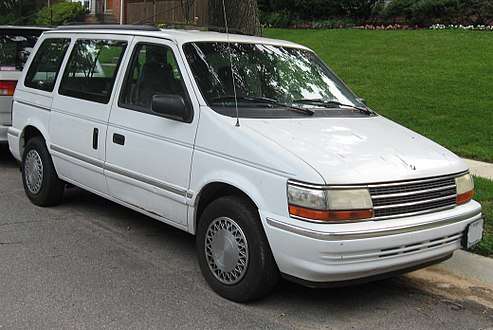
The Plymouth Voyager was modified for 1991 with new sheet metal. The S platform was still used, though renamed the "AS platform". These were the last Voyagers that were derived from the Chrysler K platform.
Trim levels were carried over from the previous generation. 1991 Voyagers were available in base, mid-grade SE, high-end LE, and high-end sporty LX. The LX which was available only on short-wheelbase Voyagers, was marketed as a sport-luxury minivan and came with the most standard equipment including alloy wheels, fog lamps, and wide array of power-operated features.[11]
In later years various trim packages were offered on SE models. The "Sport Wagon" package available from 1993–1995 featured accent color (gray) bumpers and molding, fog lamps, and special aluminum wheels.[12] The "Rallye" package offered in 1995, took the place of the departed LX model. It was more luxury-oriented, with lower body two-tone paint — regardless of upper body color, the lower body was painted "Driftwood Beige" — silver aluminum wheels, and special badging.[12] The font first used for the Rallye's badging was adopted for all of Plymouth's badging from 1996 onward.[13]
Interiors were more differentiated in this generation than on the first with a redesigned dashboard for 1994 featured a passenger-side front airbag.[13] and a seating package, marketed as "Quad Command" seating package, available on SE, LE, and LX models. Quad command replaced the 2nd row bench with two individual bucket seats with a center aisle to the 3rd row bench. Interior options varied with trim levels and packages. Cloth seating was standard on all models; leather seating was a standalone extra-cost option on LE and LX models.[11]
Only badging and minor cosmetics differentiated the Voyager from its Dodge Caravan rebadged variant.[13] The Chrysler Town & Country shared the Voyager's headlamps and taillights along with its own chrome waterfall grille.
Innovations
This generation of vans brought additional innovations, including:
- "Quad Command" bucket seating (1990)
- Available All-wheel drive (1990)
- Available anti-lock brakes (1990)
- First driver's side airbag in a minivan (1991), made standard (1991), and first dual front airbags (1993)
- Integrated child safety seats (1991), improved design with recliners (1993)
- First minivan to meet 1998 U.S. federal safety standards (1993)
The turbocharged engine and Convert-A-Bed feature were dropped.[5]
Engines
- 1991–1995 2.5 L K I4, 100 hp (75 kW), 135 lb⋅ft (183 N⋅m)
- 1991–1995 3.0 L Mitsubishi 6G72 V6, 142 hp (106 kW), 173 lb⋅ft (235 N⋅m)
- 1991–1993 3.3 L EGA V6, 150 hp (110 kW), 180 lb⋅ft (240 N⋅m)
- 1994–1995 3.3 L EGA V6, 162 hp (121 kW), 194 lb⋅ft (263 N⋅m)
- 1994–1995 3.8 L EGH V6, 162 hp (121 kW), 213 lb⋅ft (289 N⋅m)
Year-to-year changes
- 1991: Second-generation minivans released. A driver's side airbag was made standard for this year. Integrated child safety seats in the second row bench were optional on 1992 Voyagers. The Grand Voyager was available with a lower-cost powertrain. A 142 hp (106 kW) 3.0 L V6 and a 3-speed automatic could be substituted for the standard 150 hp (112 kW) 3.3 L V6 with its 4-speed automatic. The 5-speed manual transmission could once again be paired with the base engine, which was now the 2.5 liter four instead of the original 2.2 liter four.
- 1993: On 7-passenger models, the optional "Quad Command" bucket seats replaced the middle bench seat. The right bucket tilted forward to ease entry and exit to the rearmost bench. The front shoulder belts became height-adjustable and rear shoulder belts had lower anchor points and the horn button was black.
- 1994: New bumpers and body moldings, and a redesigned dashboard appeared on all 1994 Voyagers. New safety features which included a passenger-side airbag and side door-guard beams enabled the Voyager to meet all passenger car safety requirements through 1998. A cassette player became standard on all models but the base, and a CD player was available on all models. Under the hood, a 162 hp (121 kW) 3.8 L V6 was a new option for top-of-the-line Grand Voyager LE models. The 3.3 L V6 had been upgraded to produce 162 hp (121 kW) as well. For 1994 the "10 Year Anniversary Edition" was an option on Voyager SE models; it had unique two-tone paint and badges.
- 1995: No major changes were made for 1995, except for the new Rallye option package available on SE models. Rallye models came with special silver-accent wheels and special two-toned paint on the lower body.
Third generation (NS; 1996–2000)
| Third generation (NS) | |
|---|---|
 | |
| Overview | |
| Also called | Chrysler Voyager (Mexico; USA for 2000 only) |
| Production | 1996–2000 |
| Assembly |
St. Louis, Missouri, United States Windsor, Ontario, Canada |
| Body and chassis | |
| Body style |
3-door minivan 4-door minivan |
| Layout | Transverse front-engine, front-wheel drive / all-wheel drive (export only) |
| Platform | Chrysler NS platform |
| Related |
Chrysler Voyager Chrysler Town & Country Dodge Caravan |
| Powertrain | |
| Engine | |
| Transmission |
3-speed TorqueFlite automatic 4-speed 41TE automatic 4-speed 41AE automatic (AWD Grand Voyagers in non-US markets only) |
| Dimensions | |
| Wheelbase |
SWB: 113.3 in (2,878 mm) Grand: 119.3 in (3,030 mm) |
| Length |
SWB: 186.3 in (4,732 mm) Grand: 199.6 in (5,070 mm) |
| Width | 76.8 in (1,951 mm) |
| Height | 68.5 in (1,740 mm) |
| Curb weight |
3,528 lb (1,600 kg) 3,680 lb (1,669 kg) (Grand Voyager) |


The 1996 Plymouth Voyager was completely redesigned from the ground up. Gone were its K-car underpinnings and architecture, replaced with more modern components and Chrysler's acclaimed cab-forward design. The third generation redesign used the Chrysler NS platform and included a driver's-side sliding door, a minivan first. The Voyager was on Car and Driver magazine's Ten Best list for 1996 and 1997.[14][15]
As part of Chrysler's new corporate strategy to better focus the Plymouth brand on entry-level vehicles, U.S. market third generation Voyagers and Grand Voyagers were mostly available in base trim, better-equipped SE models and high-end LE models.[16] The LX model was discontinued for the third generation, having been replaced by the Chrysler Town & Country SX and LX. A Rallye option package, carried over from the previous generation, was available on the SE model.[17] It was renamed "Expresso" for 1998.[18] All-wheel drive models were discontinued in the US market, remaining available in others.[19] Unavailable in all Voyager models were fog lights, auto-dimming rear view mirrors, and a memory function for the power driver's seat in vans with that option.
Base Voyagers and Voyager SEs were easily distinguished by their body-side moldings. Base models used a narrow accent color strip and SE models used a wide accent color strip with a "Plymouth" badge above it on either front door. If equipped with the Rallye or Expresso packages, the "Plymouth" badge is replaced with a "Rallye" or "Expresso" badge. LEs used the same body-side molding as the Dodge Caravan LE, which extended to the bottom of the doors, with a double pinstripe and "LE" decal above. The vinyl woodgrain-appearance side paneling was no longer available, as the new side sheetmetal was no longer flat.[20]
Third generation Voyagers introduced a new system of rear seats to simplify installation, removal, and re-positioning— marketed as "Easy-Out Roller Seats". All Voyagers and Grand Voyagers were equipped with this feature. When installed, the 2nd and 3rd row seats (either bucket or bench seats) were latched to floor-mounted strikers. When unlatched, eight rollers lifted each seat, allowing it to be rolled fore and aft. Tracks had locator depressions for rollers, thus enabling simple installation. Ergonomic levers at the seatbacks released the floor latches single-handedly without tools and raised the seats onto the rollers in a single motion. Additionally, seatbacks were designed to fold forward. Seat roller tracks were permanently attached to the floor and seat stanchions were aligned, facilitating the longitudinal rolling of the seats. Bench seat stanchions were moved inboard to reduce bending stress in the seat frames, allowing them to be lighter.
Engines
- 1996–2000 2.4 L EDZ I4, 150 hp (110 kW), 167 lb⋅ft (226 N⋅m) (Canadian vans beginning in 1999 included a 3.0 L V6 as standard equipment)
- 1996–2000 3.0 L Mitsubishi 6G72 V6 150 hp (110 kW), 176 lb⋅ft (239 N⋅m) (not available in certain U.S. states, 3.3 L V6 offered as standard equipment in those states instead)
- 1996–2000 3.3 L EGA V6, 158 hp (118 kW), 203 lb⋅ft (275 N⋅m)
- 1999 3.8 L EGH V6, 180 hp (130 kW), 240 lb⋅ft (330 N⋅m)
Year-to-year changes
- 1996: As running changes during this model year, the Pentastar front logo and rear badging carried over from the previous generation were replaced with the new "sailboat" logo and script font, while the front interior door panels were redesigned, losing the discrete grab handles in favor of ones integrated into the armrests.
- 1997: A CD player was a new option. Other than that, only minimal changes.
- 1998: Grocery bag hooks were added to the rearmost bench. The Rallye package was renamed Expresso and now included new wheel covers (if equipped with steel wheels), a standard CD player and a body-colored grille). SE models with optional low-back seats and LE models received updated cloth upholstery. As a running change during this model year, the HVAC vents on the driver's side and in the center of the dashboard were changed to a more conventional design.
- 1999: The 3.8 L V6 was made available for SE models; it was already available on the LE model, Caravan and Town & Country. A small cargo net between the front seats, additional standard equipment, integrated child-safety seats and second-row buckets were added to the Voyager this year. Air conditioning was made standard on SE models. In Canada, the 3.0L V6 was made standard equipment. 1999 also saw the addition of a one-year-only 15th anniversary "Platinum Edition", to mark Caravan's 15th year of production. This package was offered on various trim levels, and included Platinum Metallic paint, and fender badges.
- 2000: Now standard on all models was air conditioning, power windows, and power locks (the latter two standard on SE models only). A dealer-installed rear-seat video entertainment system was newly available on all models. The 2000 model year offered packages which included the "2000+" and "Millennium" package; however these were little more than unique fender badges on vans with popular equipment.
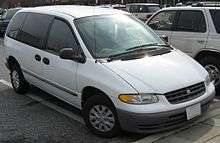
In 1999, Plymouth's demise was announced, resulting in the 2000 Voyager/Grand Voyager models in the US doing double duty as both Plymouths and Chryslers.
Crash test results
The 1996-2000 Dodge Grand Caravan (twin of the Voyager/Grand Voyager) received a "Marginal" rating in the Insurance Institute for Highway Safety's 40 mph offset test. The structural performance and restraints were graded "Acceptable", but the foot injuries were very high.
In the NHTSA crash tests, it received 4 stars for the driver and front passenger in the frontal-impact. In the side-impact test, it received 5 stars for the driver, and 3 stars for the rear occupant, and resulted in a fuel leak that could cause a fire hazard.
Fourth generation (RS; 2001-2003)
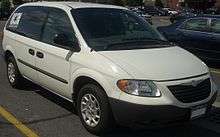
For the fourth generation of the minivan in 2001, the Plymouth Voyager was rebadged as the Chrysler Voyager in the US. It was offered in the short wheelbase only. The Chrysler Voyager was discontinued after 2003 and the short wheelbase Chrysler minivan became part of the Town & Country line. However, the short wheelbase Town & Country continued under the Voyager nameplate until 2007 in Mexico.
Trim levels
- Base – 1984–2000
- LE – 1984–1999 (unavailable in US for third generation; replaced by standalone Rallye and Expresso models)
- SE – 1984–2000
- LX – 1989–1992
- Sport Wagon – 1993–1995 (package available on SE and LE)
- Rallye – 1995–1997 (1995 as a package on SE and LE; 1996–1997 as either a package on SE or standalone model)
- Expresso – 1998–2000 (as a package on SE or standalone model)
Minivan production
Chrysler's plant in St. Louis, Missouri was responsible for building the Voyager from 1990 to 2000.
References
- ↑ "Chrysler LLC Celebrates 25th Anniversary of the Minivan". Autonew24h.com.
- ↑ 1974 Plymouth Voyager promotional postcard (McLellan's Automotive)
- ↑ Readers' Rides; 1974 Plymouth Voyager (Grassroots Motorsports)
- ↑ The Matra/Renault Espace
- 1 2 "A Brief History of the Chrysler Minivan". Allpar. Retrieved 2008-06-13. External link in
|journal=(help) - ↑ "A Brief History of the Chrysler Minivan" Information courtesy of Chrysler, allpar, retrieved on 2010–08–23.
- ↑ "1984 plymouth voyager commercial", retrieved on 2010–08–25.
- ↑ "1989 Tina Turner Plymouth Voyager Commercial", retrieved on 2010–08–25.
- ↑ "Celine Dion : 1990 Dodge Caravan & Plymouth Voyager", retrieved on 2010–08–25.
- ↑ Chrysler Corporation Factory Sales Brochure "1986 Plymouth full-line"
- 1 2 Chrysler Corporation Factory Sales Brochure "1991 Plymouth Voyager/Grand Voyager"
- 1 2 "Used Plymouth Prices", retrieved on 2010–08–23.
- 1 2 3 "1991-1995 Chrysler minivans: Dodge Caravan, Plymouth Voyager, Chrysler Town & Country" Information courtesy of Chrysler, allpar, retrieved on 2010–08–23.
- ↑ "1996 10Best Cars", retrieved on 2010–08–24.
- ↑ "1997 10Best Cars" Archived 2012-07-30 at Archive.is, retrieved on 2010–08–24.
- ↑ Yates, Brock W (1996). The Critical Path: Inventing an Automobile and Reinventing a Corporation (1st Edition). Little, Brown. p. 210.
- ↑ Chrysler Corporation Factory Sales Brochure "1996 Plymouth Voyager/Grand Voyager"
- ↑ Chrysler Corporation Factory Sales Brochure "1998 Plymouth Voyager"
- ↑ "Chart of Available Trim Levels", retrieved on 2017-12-05.
- ↑ Yates, Brock W (1996). The Critical Path: Inventing and Automobile and Reinventing a Corporation (1st Edition). Little, Brown.
External links
| Wikimedia Commons has media related to Plymouth Voyager. |
- Allpar.com minivans - Plymouth Voyager/Grand Voyager for all generations
- "Generations: Chrysler, Dodge and Plymouth Minivans". Edmunds.com. Archived from the original on August 31, 2005. Retrieved January 3, 2006.
- ConsumerGuide: Second Generation Voyager
- ConsumerGuide: Third Generation Voyager
« previous — Plymouth road car timeline, 1970s–2001, United States market | ||||||||||||||||||||||||||||||||
|---|---|---|---|---|---|---|---|---|---|---|---|---|---|---|---|---|---|---|---|---|---|---|---|---|---|---|---|---|---|---|---|---|
| Type | 1970s | 1980s | 1990s | 2000s | ||||||||||||||||||||||||||||
| 0 | 1 | 2 | 3 | 4 | 5 | 6 | 7 | 8 | 9 | 0 | 1 | 2 | 3 | 4 | 5 | 6 | 7 | 8 | 9 | 0 | 1 | 2 | 3 | 4 | 5 | 6 | 7 | 8 | 9 | 0 | 1 | |
| Subcompact | Cricket | Horizon | ||||||||||||||||||||||||||||||
| TC3 | Turismo | |||||||||||||||||||||||||||||||
| Champ/Colt | Colt | Colt | Colt | |||||||||||||||||||||||||||||
| Compact | Arrow | Sundance | Neon | Neon | ||||||||||||||||||||||||||||
| Colt | Colt | Colt | ||||||||||||||||||||||||||||||
| Valiant | Volaré | Reliant | ||||||||||||||||||||||||||||||
| Mid-size | Caravelle | Acclaim | Breeze | |||||||||||||||||||||||||||||
| Satellite | Fury | Gran Fury | ||||||||||||||||||||||||||||||
| Full-size | Fury | Gran Fury | Gran Fury | |||||||||||||||||||||||||||||
| Sports | Duster | Sapporo | Laser | |||||||||||||||||||||||||||||
| Road Runner | Road Runner | Road Runner | Conquest | |||||||||||||||||||||||||||||
| Barracuda | Prowler | Prowler | ||||||||||||||||||||||||||||||
| GTX | ||||||||||||||||||||||||||||||||
| SUV | Trailduster | |||||||||||||||||||||||||||||||
| Pickup | Arrow Truck | Scamp | ||||||||||||||||||||||||||||||
| Compact MPV | Colt Vista | |||||||||||||||||||||||||||||||
| Minivan | Voyager/Grand Voyager | Voyager/Grand Voyager | Voyager/Grand Voyager | |||||||||||||||||||||||||||||
| Van | Voyager | |||||||||||||||||||||||||||||||